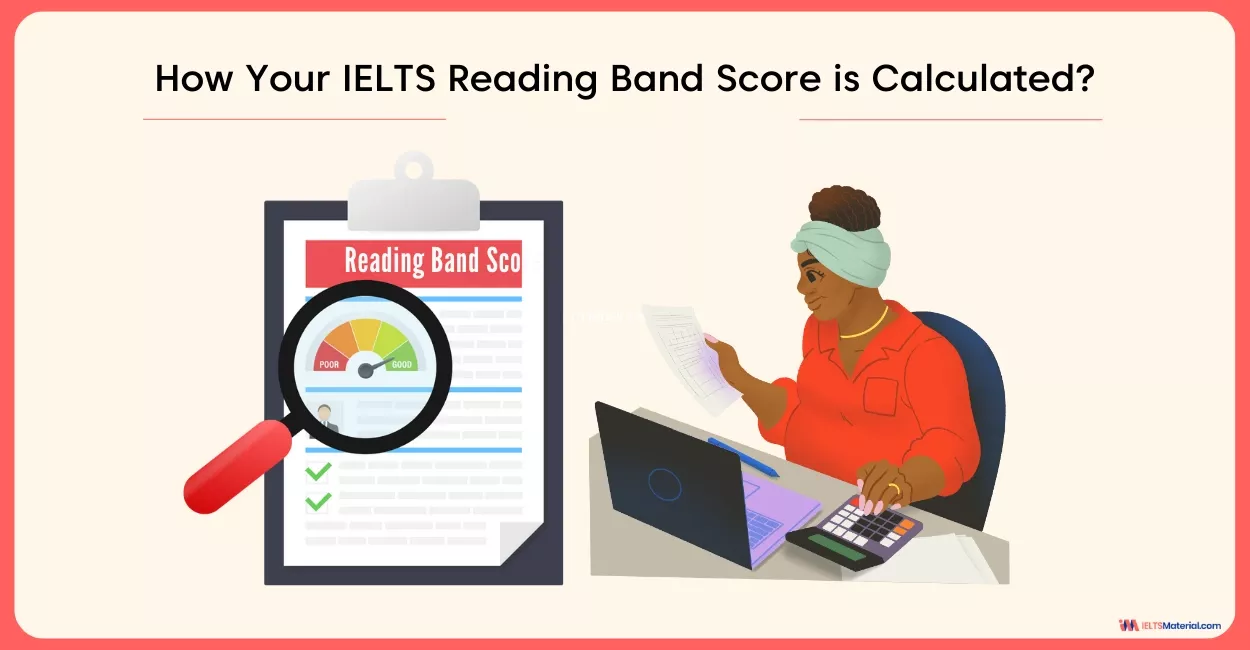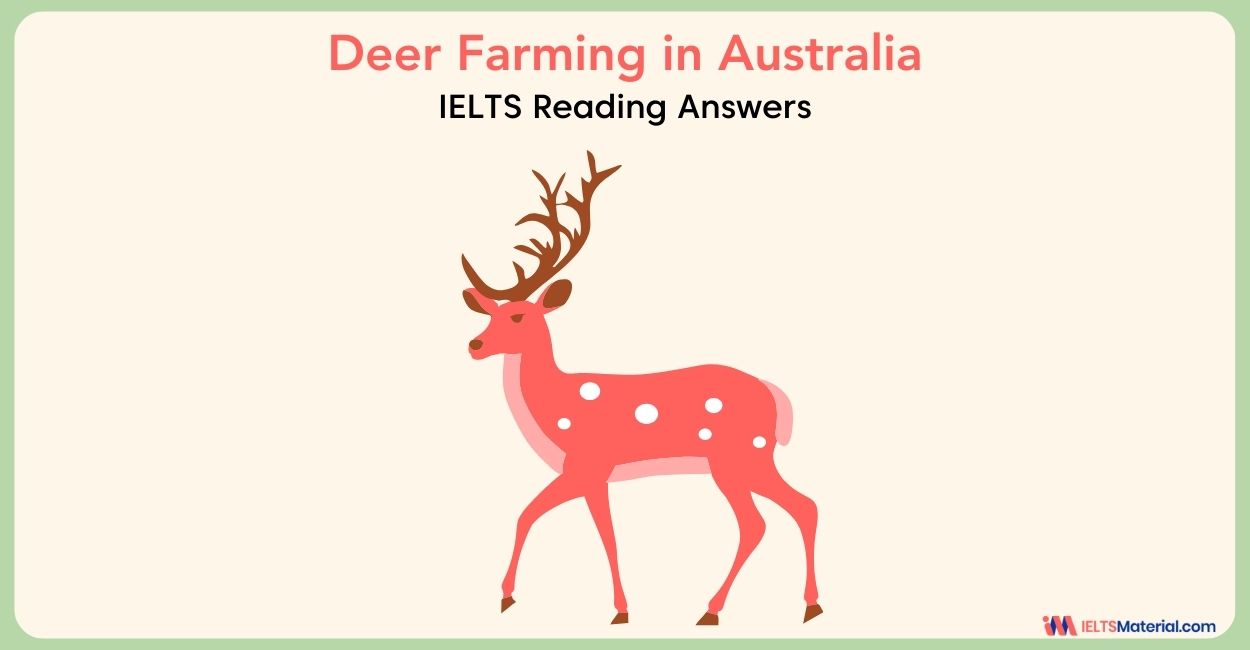Deer Farming in Australia - IELTS Reading Answers
8 min read
Updated On
-
Copy link
This blog provides complete answers for the IELTS Reading passage Deer Farming in Australia, including exact answer locations, detailed explanations, and expert tips to help you confidently tackle all question types and improve your reading performance.
Table of Contents

Limited-Time Offer : Access a FREE 10-Day IELTS Study Plan!
Deer Farming in Australia is a real Reading test passage that appeared in the IELTS. With diligent practice, the Reading Module can be the top-scoring category for IELTS Aspirants. To score well, you must understand how to approach and answer the different question types in the Reading Module.
By solving and reviewing Sample Reading Questions from past IELTS papers, you can ensure that your Reading skills are up to the mark. Take the practice test Deer Farming in Australia below and try more IELTS reading practice tests from IELTSMaterial.com.
Not sure how to answer True/False/Not Given questions? Take a look at the video below to learn now!
Deer Farming in Australia - IELTS Reading Passage
You should spend about 20 minutes on Questions 28 - 40, which are based on the Reading Passage below.
Paragraph A
Deer are not indigenous to Australia. They were introduced into the country during the nineteenth century under the acclimatization programs governing the introduction of exotic species of animals and birds into Australia. Six species of deer were released at various locations. The animals dispersed and established wild populations at various locations across Australia, mostly depending upon their points of release into the wild. These animals formed the basis for the deer industry in Australia today. Commercial deer farming in Australia commenced in Victoria in 1971 with the authorized capture of rusa deer from the Royal National Park, NSW. Until 1985, only four species of deer, two from temperate climates (red, yellow) and two tropical species (rusa, chital) were confined for commercial farming. Late in 1985, pressure from industry to increase herd numbers saw the development of import protocols. This resulted in the introduction of large numbers of red deer hybrids from New Zealand and North American elk directly from Canada. The national farmed deer herd is now distributed throughout all states although most are in New South Wales and Victoria.
Paragraph B
The number of animals processed annually has continued to increase, despite the downward trend in venison prices since 1997. Of concern is the apparent increase in the number of female animals processed and the number of whole herds committed for processing. With more than 40,000 animals processed in 1998/99 and 60,000 in 1999/2000, there is justified concern that future years may see a dramatic drop in production. At least 85% of all venison produced in Australia is exported, principally to Europe. At least 90% of all velvet antler produced is exported in an unprocessed state to Asia. Schemes to promote Australian deer products continue to have a positive effect on sales that in turn have a positive effect on prices paid to growers. The industry appears to be showing limited signs that it is emerging from a state of depression caused by both internal and external factors that include: (i) the Asian currency downturn; (ii) the industry's lack of competitive advantage in influential markets (particularly in respect to New Zealand competition), and (iii) within industry processing and marketing competition for limited product volumes of venison.
Paragraph C
From the formation of the Australian Deer Breeders Federation in 1979, the industry representative body has evolved through the Deer Farmers Federation of Australia to the Deer Industry Association of Australia Ltd (DIAA), which was registered in 1995. The industry has established two product development and marketing companies, the Australian Deer Horn and Co-Products Pty Ltd (ADH) and the Deer Industry Projects and Development Pty Ltd, which trades as the Deer Industry Company (DIC). ADH collects and markets Australian deer horn and co-products on behalf of Australian deer farmers. It promotes the harvest of velvet antler according to the strict quality assurance program promoted by the industry. The company also plans and coordinates regular velvet accreditation courses for Australian deer farmers.
Paragraph D
Estimates suggest that until the early 1990s the rate of the annual increase in the number of farmed deer was up to 25%, but after 1993 this rate of increase fell to probably less than 10%. The main reasons for the decline in the deer herd growth rate at such a critical time for the market were: (i) severe drought conditions up to 1998 affecting eastern Australia during 1993-96 and (ii) the consequent slaughter of large numbers of breeding females, at very low prices. These factors combined to decrease confidence within the industry. Lack of confidence saw a drop in new investment within the industry and a lack of willingness of established farmers to expand their herds. With the development of strong overseas markets for venison and velvet and the prospect of better seasons ahead in 1996, the trends described were seen to have been significantly reversed. However, the relatively small size of the Australian herd was seen to impose undesirable restraints on the rate at which herd numbers could be expanded to meet the demands for products. Supply difficulties were exacerbated when the supply of products, particularly venison, was maintained by the slaughter of young breeding females. The net result was depletion of the industry ’s female breeding herds.
Paragraph E
Industry programs are funded by statutory levies on sales of animals for venison, velvet antler sales and the sale of live animals into export markets. The industry has a 1996-2000 five year plan including animal nutrition, pasture quality, carcass quality, antler harvesting, promotional material and technical bulletins. All projects have generated a significant volume of information, which complements similar work undertaken in New Zealand and other deer farming countries. Major projects funded by levy funds include the Venison Market Project from 1992 to 1996. This initiative resulted in a dramatic increase in international demand for Australian venison and an increase in the domestic consumption of venison. In an effort to maintain existing venison markets in the short term and to increase them in the long term, in 1997 the industry’s top priority became the increase in size and production capacity of the national herd.
Want to improve your IELTS Academic Reading score? Grab Our IELTS Reading Ebook Today!
Deer Farming in Australia - IELTS Reading Questions
Questions 28-32
The reading passage on Deer Farming In Australia has 5 paragraphs ( A – E ).
From the list of headings below choose the most suitable headings for paragraphs A – E.
Write the appropriate number (i – viii) in boxes 28 – 32 on your answer sheet.
NB There are more headings than paragraphs, so you will not use them all.
i. Industry Structures
ii. Disease Affects Production
iii. Trends in Production
iv. Government Assistance
v. How Deer Came to Australia
vi. Research and Development
vii. Asian Competition
viii. Industry Development
28. Paragraph A
29. Paragraph B
30. Paragraph C
31. Paragraph D
32. Paragraph E
Questions 33-37
Read the passage 'Deer Farming in Australia' and look at the statements below.
In boxes 33 -37 on your answer sheet write:
TRUE if the statement is true
FALSE if the statement is false
NOT GIVEN if the information is not given in the reading passage
33. Until 1985 only 2 species of the originally released Australian deer were not used for farming.
34. Since 1985 many imported deer have been interbred with the established herds.
35. The drop in deer numbers since 1997 led to an increase in the price of venison.
36. Only a small amount of Australian venison production is consumed domestically.
37. Current economic conditions in Asian countries have had positive effects on the Australian deer industry.
Questions 38-40
Complete each of the following statements (Questions 38 -40 )with words taken from Reading Passage 29.
Write NO MORE THAN THREE WORDS for each answer. Write your answers in boxes 38-40 on your answer sheet.
38. A stringent .................. allows the Australian deer industry to maintain their excellence of product.
39. Herd stock expansion was made difficult by the killing of ................... to continue product supply.
40. Foreign and home markets for Australian venison increased due to the ............................
Want to boost your IELTS score? Enroll in our expert-led IELTS online classes today!
Deer Farming in Australia - IELTS Reading Answers
Let’s now review the answers to the questions from the passage in the reading section, Deer Farming in Australia - IELTS Reading Answers, and assess your improvement for a high IELTS Reading band score.
| Question Number | Answers | Keywords | Location of Keywords |
|---|---|---|---|
| 28. | v | Not indigenous, were introduced, deer farming | Paragraph A |
| 29. | viii | Venison produced, exported, industry | Paragraph B |
| 30. | i | Has established, product development and marketing | Paragraph C |
| 31. | iii | Increase, farmed deer, growth rate | Paragraph D |
| 32. | vi | Five year plan, major projects | Paragraph E |
| 33. | True | Six species, only four, farming | Paragraph A, Lines 4 & 11-13 |
| 34. | Not Given | Not Given | Not Given |
| 35. | False | Continued to increase, downward trend, 1997 | Paragraph B, First 2 lines |
| 36. | True | At least 85%, venison, exported | Paragraph B, Lines 8-9 |
| 37. | Not Given | Not Given | Not Given |
| 38. | Quality assurance program | Promotes the harvest, assurance program | Paragraph C, Last 4 lines |
| 39. | Breeding females | Supply difficulty, slaughter | Paragraph D, Last 3 lines |
| 40. | Venison Market Project | Dramatic increase, demand | Paragraph E, Lines 10-12 |
Practice with the IELTS Reading Recent Actual Tests to improve your accuracy using real exam questions and answers!
Tips for Answering the Question Types in Deer Farming in Australia - IELTS Reading Answers
Let us check out some quick IELTS Exam Preparation Tips for Band Score of 8+ to answer the three types of questions in the Reading Answers.
Matching Headings
Reading Matching Headings requires you to match each paragraph or section of the passage with the most suitable heading. Here are some tips:
- Read the Headings First – Familiarize yourself with all options before scanning the passage.
- Skim Paragraphs for Main Ideas – Focus on the topic sentence or first few lines to capture the paragraph’s theme.
- Look for Keywords and Synonyms – The passage often uses different wording than the headings.
- Eliminate Irrelevant Headings – Cross off headings that clearly don’t match to narrow choices.
- Don’t Overthink Small Details – Headings summarize the overall idea, not minor details.
True/False/Not Given
You need to decide whether statements agree with the information in the passage (True), contradict it (False), or cannot be determined (Not Given). Here are some tips to ace True/False/Not Given:
- Underline Keywords in the Statement – Helps you locate relevant sentences in the passage.
- Scan for Synonyms and Paraphrases – The passage rarely uses the exact words.
- Avoid Assumptions – Base your answer only on the text, not your knowledge.
- Carefully Compare Statement and Passage – True = matches, False = contradicts, Not Given = not mentioned.
- Watch for Qualifiers – Words like all, some, always, never can change the answer.
Sentence Completion
You fill in the blanks in sentences using words from the passage in the Reading Sentence Completion, testing your ability to locate and paraphrase information. Following are some tips:
- Read the Whole Sentence First – Understand the context before searching in the passage.
- Identify Keywords in the Blank – Look for nouns, verbs, or phrases to locate the answer quickly.
- Scan the Passage Efficiently – Use keywords to find the relevant sentence.
- Check Word Limits – Follow instructions carefully, e.g., one, two, or three words only.
- Maintain Grammatical Accuracy – Ensure the inserted word fits the sentence grammatically.
Confused about IELTS prep? Join our exclusive IELTS webinar and clear all your doubts!
Mastering IELTS Reading passages like 'Deer Farming in Australia' requires not just finding the right answers but also understanding the logic behind them. With answer explanations, answer locations, and tips for each question type, this blog equips you with the strategies needed to boost accuracy and manage time effectively. Keep practicing with similar passages to build confidence and achieve a higher IELTS Reading band score.
Check More IELTS Reading Answers
Practice IELTS Reading based on question types

Start Preparing for IELTS: Get Your 10-Day Study Plan Today!
Recent Articles

Nehasri Ravishenbagam

Haniya Yashfeen

Haniya Yashfeen

Haniya Yashfeen




Post your Comments